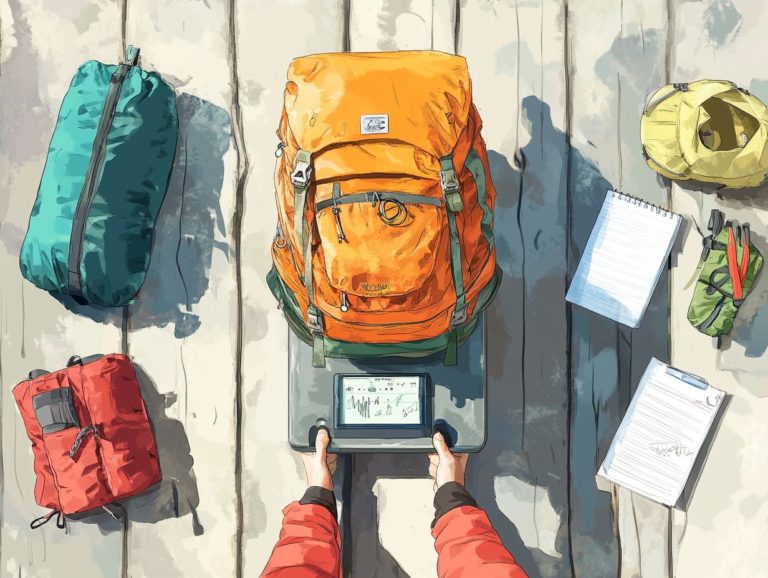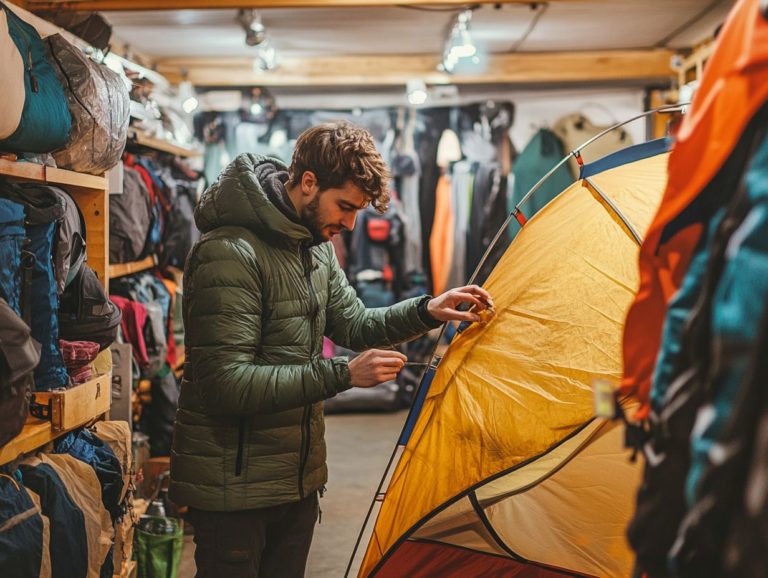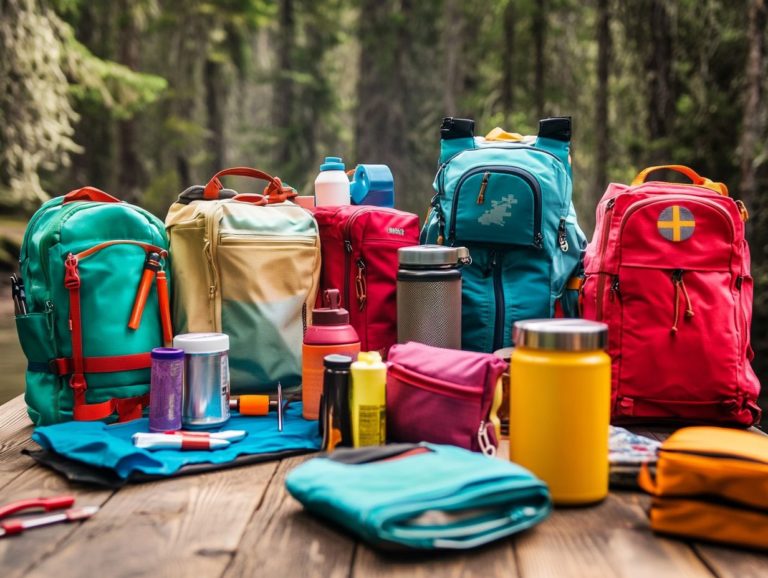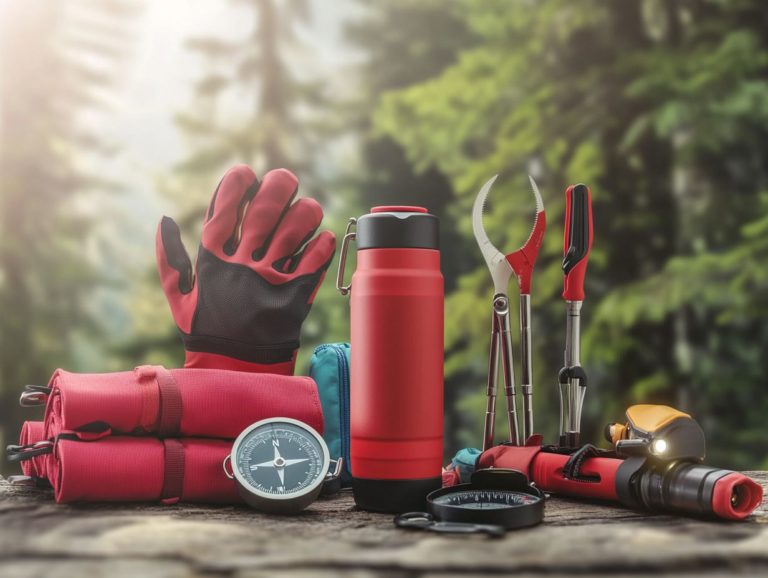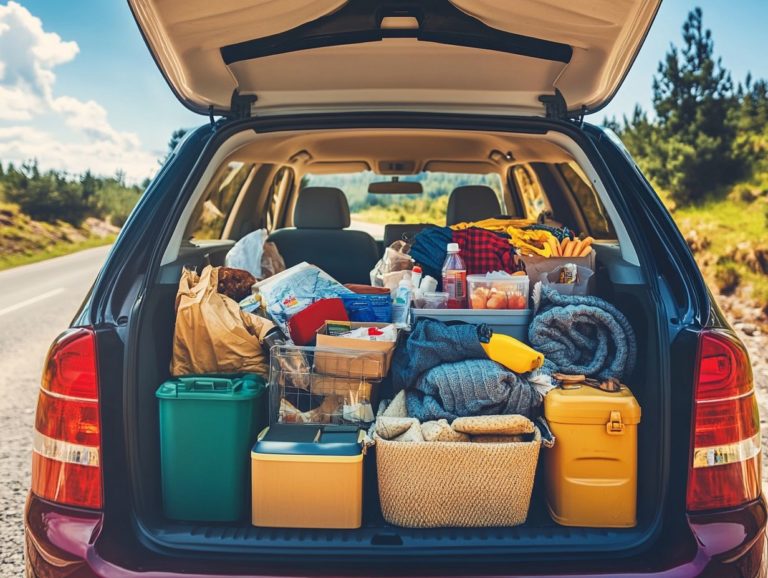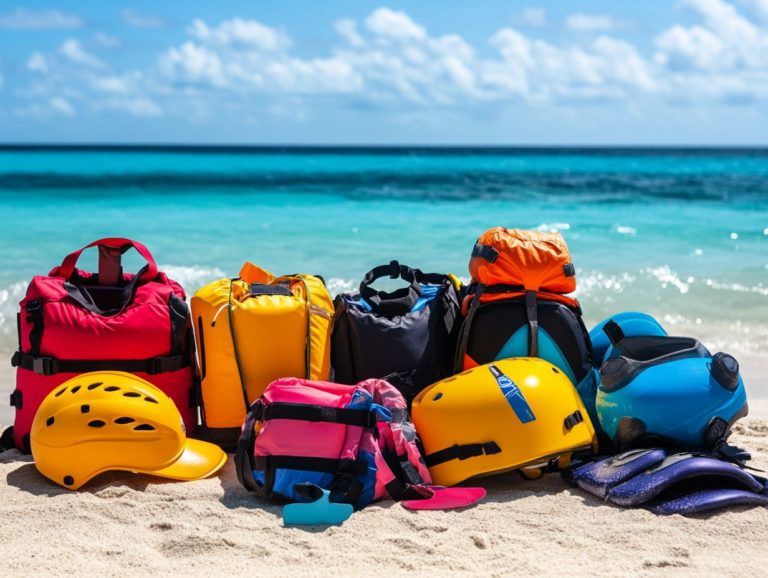What is the Importance of Outdoor Gear Testing?
Before you set off on your next outdoor adventure, the significance of reliable gear cannot be overstated; it truly shapes your experience.
Outdoor gear testing is essential in guaranteeing that products perform optimally while ensuring your safety and satisfaction. This article delves into the importance of various testing methods, comparing field and laboratory approaches, and underscores critical factors such as environmental conditions and product durability.
By grasping the advantages of comprehensive testing, you ll come to recognize how these practices elevate both product quality and the overall enjoyment of your outdoor pursuits.
Contents
Key Takeaways:

- Outdoor gear testing ensures product quality and safety, helping you avoid common buying mistakes.
- Field and laboratory testing both evaluate outdoor gear performance effectively.
- Environmental conditions play a critical role in testing accuracy.
Why Outdoor Gear Testing Matters
The purpose of outdoor gear testing is to equip you, the outdoor enthusiast, with trustworthy insights regarding the performance, usability, and durability of various hiking gear and outdoor equipment.
Through thorough product reviews, gear reviewers evaluate equipment in both challenging field conditions and controlled environments. This meticulous process fosters vital communication between users and manufacturers, enhancing user feedback.
This approach helps you avoid costly purchasing mistakes and enables you to make informed decisions about your outdoor adventures, whether you re selecting camping essentials or lightweight tents.
Why is it Necessary?
Testing outdoor gear is essential to help you avoid common mistakes when buying. It ensures you re equipped with the finest products for your outdoor adventures.
Without a thorough evaluation, the dangers of buying subpar items become all too clear. Inadequate testing can lead to equipment failure at critical moments, putting both your safety and enjoyment on the line. Imagine hiking with a flimsy backpack that can’t hold your gear, leaving you uncomfortable and distracted.
On the flip side, reliable information from detailed gear reviews provides invaluable insights, enabling you to select products with proven performance and durability.
Take, for example, a well-reviewed tent that can withstand harsh weather conditions, ensuring you have a cozy haven during an unexpected storm. Always check reviews before your next purchase to ensure you re ready for any adventure!
Types of Outdoor Gear Testing
There are two essential types of outdoor gear testing: field testing and laboratory testing, both of which are crucial for assessing equipment performance and ensuring your safety.
Field testing immerses the gear in real-world conditions, allowing for a comprehensive evaluation of its capabilities. On the other hand, laboratory testing offers a controlled environment to rigorously assess specific factors like waterproof performance and overall durability.
Each method complements the other, ensuring that your outdoor gear is not only reliable but also meets the highest standards of quality.
Field Testing vs. Laboratory Testing
Field testing and laboratory testing each play a crucial role in the outdoor gear testing landscape, offering you valuable insights into the relationship between gear and performance based on real-world experiences.
Field testing shows how gear performs in nature, while lab testing verifies its design under controlled conditions. This contrast between the two environments illuminates how real-life usage can reveal hidden issues that might not surface in a sterile lab setting.
Ultimately, both methods work hand in hand to provide a comprehensive understanding of gear capabilities, enabling you with informed recommendations that can elevate your outdoor adventures to new heights.
The Importance of Proper Testing Methods

Proper testing methods are essential for ensuring accuracy and reliability in your outdoor gear assessments. These factors significantly influence your user experience and the durability of the products you choose.
By employing careful testing methods, you can offer honest feedback that genuinely reflects the true performance of hiking gear and outdoor equipment. This commitment to thorough evaluation enhances your credibility and enables fellow adventurers to make informed decisions.
Ensuring Accuracy and Reliability
Ensuring accuracy and reliability during your testing process is crucial for aligning product performance with equipment expectations and user needs.
To achieve this, you should follow a series of carefully crafted steps, starting with establishing standardized testing protocols. These protocols guarantee that every product, from new sports gear to advanced electronic devices, undergoes a consistent evaluation process essential for equipment evaluations.
Take, for example, the assessment of a new pair of running shoes. You ll measure metrics such as cushioning performance and durability against industry standards. After these assessments are complete, you analyze the results to draw meaningful conclusions about the gear s effectiveness. This not only aids in product development but also provides valuable insights to consumers about what they can expect.
Ultimately, your findings have a significant impact on enhancing user experiences by ensuring that the equipment meets pre-determined performance criteria.
Factors to Consider in Outdoor Gear Testing
When testing outdoor gear, consider the following key factors:
- Environmental conditions
- Realistic scenarios
These aspects guarantee that the gear performs at its best in real-world experiences.
A thorough understanding of how various conditions can impact performance, safety, and overall user satisfaction is essential for effective outdoor gear testing. This approach ensures that you can rely on your gear when it matters most.
Environmental Conditions and Realistic Scenarios
Environmental conditions and realistic scenarios significantly influence the performance analysis of outdoor gear during testing. It s essential to evaluate your gear under various weather conditions and terrains that you might encounter on your hikes.
For example, rain can compromise your grip on slick surfaces, while snow can impact insulation and mobility, presenting real challenges. If you’re relying on boots that lack waterproofing, you might find yourself, to your dismay, with soaked and cold feet long before you reach your destination.
Similarly, a poorly designed jacket might falter in heavy snow, leaving you exposed to the biting cold. These failures highlight why comprehensive testing is a must! It’s not just about durability it’s about how your gear adapts and performs when faced with real-world challenges.
These experiences remind us that only thorough evaluations across different conditions can ensure reliable performance when it counts the most.
Testing for Safety and Durability
Testing for safety and durability is essential in assessing outdoor gear. It ensures that the products you choose can endure the challenges of your adventures while meeting your expectations.
By utilizing rigorous methods like stress testing, impact resistance assessments, and environmental simulations, brands can accurately gauge how their equipment will perform in real-world scenarios. For instance, tents frequently undergo wind tunnel tests to evaluate their stability against gusts, while hiking boots are subjected to water resistance evaluations to see how well they shield you from the elements.
User feedback is invaluable in these assessments, offering practical insights that manufacturers might overlook. This input ultimately drives improvements and refinements, making gear not only safer but also more user-friendly for you, the outdoor enthusiast.
So, get out there and start testing your gear today!
Benefits of Outdoor Gear Testing

The advantages of outdoor gear testing go far beyond simple evaluations. They play an important part in elevating product quality and enhancing customer satisfaction. By performing detailed performance tests and offering comprehensive gear recommendations, testers ensure you have access to top-tier outdoor equipment tailored to your unique needs.
Improving Product Quality and Performance
Improving product quality and performance is a key advantage of outdoor gear testing. This creates a dynamic feedback loop between outdoor professionals and manufacturers.
When you share your experiences through detailed reviews, you provide invaluable insights that guide design upgrades and enhance functionality. For example, an outdoor brand recently transformed its tent design after avid campers pointed out issues with weight distribution and setup ease. This thoughtful change resulted in a lighter, user-friendly model and significantly elevated customer satisfaction ratings.
A hiking boot manufacturer used review data to improve grip and comfort, leading to a product that consistently earns high marks for trail performance. These case studies underscore the vital role of ongoing performance analysis and user feedback in driving meaningful improvements within the outdoor equipment industry.
Ensuring Customer Satisfaction
Ensuring customer satisfaction is a vital advantage of outdoor gear testing. It provides outdoor enthusiasts with reliable information to make informed purchasing decisions.
Access to honest assessments of products boosts your confidence in your choices. This fosters a positive feedback loop between you and your chosen brands. By prioritizing transparency and accuracy, companies cultivate loyalty that meets your immediate needs and encourages future engagement. Building trust is key to great relationships between you and the brands you value.
A strong relationship built on trust improves your overall satisfaction, paving the way for ongoing support and advocacy in a competitive market. This is especially true when brands leverage their social media presence to engage with outdoor enthusiasts.
Frequently Asked Questions
What is the Importance of Outdoor Gear Testing?
Outdoor gear testing involves evaluating and assessing the performance, durability, and safety of outdoor equipment before it becomes available to the public. This step is crucial in ensuring that outdoor gear meets necessary standards and is suitable for use in various environments and activities.
Why is Outdoor Gear Testing Necessary?

Outdoor gear testing is essential for ensuring the quality and reliability of outdoor equipment. It helps identify potential flaws or weaknesses, including issues with waterproof capabilities, which are features that prevent water from entering the gear, ensuring you stay dry. Addressing these issues before reaching consumers leads to safer and more effective gear for outdoor enthusiasts.
Who Conducts Outdoor Gear Testing?
Outdoor gear testing is typically conducted by professional testing organizations, gear companies, and independent experts. These individuals and organizations possess the necessary knowledge, expertise, and equipment to evaluate and test outdoor gear properly.
What are the Benefits of Outdoor Gear Testing?
Outdoor gear testing offers several benefits, including improved safety, enhanced performance, and increased durability. Durability testing plays a significant role in this process. It helps manufacturers identify potential design flaws or manufacturing errors, leading to better quality products for consumers.
Don’t wait to experience the difference! Engage with the outdoor testing community and discover the benefits for yourself.
How is Outdoor Gear Testing Performed?
Outdoor gear testing puts equipment through conditions that mimic real-world use. This includes extreme weather, rough terrain, and everyday wear and tear, along with checking how easy the product is to use.
The gear is then evaluated against specific standards to assess its performance and durability. Discover how outdoor gear is tested under extreme conditions!
Is Outdoor Gear Testing Regulated?
Yes, outdoor gear testing is regulated to ensure safety and quality. The Consumer Product Safety Commission (CPSC) in the U.S. oversees this testing, while other countries have their own agencies, such as the Washington Trails Association and REI.
Learn how these regulations protect you in the great outdoors!

